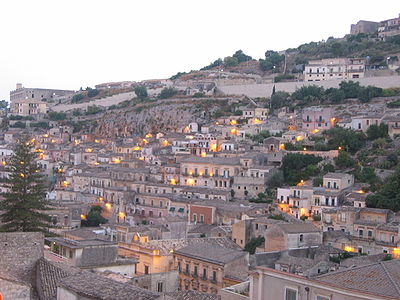MODICA
Its name derives for the term
Mùrika, meaning bare rock, named by the Siculi, founders
of the first nucleus of habitation during the 14th Century
BC.
But the rocky spur on which the City rests, was already inhabited
since the Bronze age, as testified by the archaeological finds,
including that of a detached Bronze Deposit (16th Century)
which was recovered in the City and is now preserved in the
Prehistoric Museum of Rome.
The City first fell into Phoenician then Greek hands, then
became a hostile city against Rome during the Punic Wars (212BC).
Once it was annexed to the Republic, it became a Decuman City,
and later a stipendiarla (waged) one during Imperial times.
It was one of the initial cities of the peninsular to undergo
a process of Christianity through the arrival in Sicily of
the first apostles and preachers of the new doctrine. To testify
this fact, many catacombs were discovered dug out in the rocks
and the Grotto of the Saints, with images of 33 martyred saints
in Syracuse where Christians were persecuted.
After the fall of Rome and the changeover to the Vandali,
Modica became a Byzantine stronghold until the arrival of
the Arabs in ‘845, who renamed it Mudigah and gave it
a period of splendour and a flourishing commercial time.
Taken by the Normans, with Ruggero I of Sicily, it became
a royal governing City by his son Ruggero II d’Altavilla,
who then gave Modica to Gulatiero II° Mohac in thanks
for his military enterprises.
The City was next governed by the Angioini (13th Century),
whom the population disliked to such a point that it led to
the famous outbreak of the Vespri Siciliani (Sicilian Vespers)
(5th April 1282), which inflamed the island for many years.
Modica rebelled against the French led by Federico Mosca,
who was later bestowed the title of Count of Modica by the
Aragonese.
Next followed the nobles of Chiaramonte (from 25th March 1296)
who were of Norman origins, the Cabrera, who helped Aragona
Martino the Young to conquer the crown of Sicily (1392), the
Henriquez-Cabrera in the ‘600s, by the Alvarez de Toledo
and Fitz-Stuart.
Gravely damaged in 1613 and 1693 by earthquakes, Modica was
reconstructed and took on its current modern day architectonic
and urban appearance.
There are numerous monuments and places of cultural interest
in the City, amongst which the following: the Cathedral of
San Giorgio, from the late Baroque era and protected today
by UNESCO, as is the Duomo of San Pietro, both having the
most ancient foundations and reconstructed after devastating
earthquakes of 1693.
The Castello dei Conti (Castle of the Counts) is also very
beautiful, even though many of its original parts are missing.
Modica is the birth city of Salvatore Quasimodo, a poet who
received the Nobel Prize for Literature in 1959.
|
